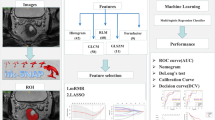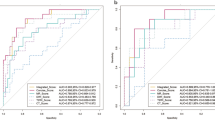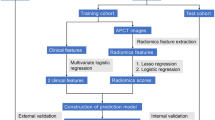Abstract
Purpose
To develop and validate a computed tomography (CT) radiomics nomogram from multicentre datasets for preoperative prediction of perineural invasion (PNI) in colorectal cancer.
Methods
A total of 299 patients with histologically confirmed colorectal cancer from three hospitals were enrolled in this retrospective study. Radiomic features were extracted from the whole tumour volume. The least absolute shrinkage and selection operator logistic regression was applied for feature selection and radiomics signature construction. Finally, a radiomics nomogram combining the radiomics score and clinical predictors was established. The receiver operating characteristic curve and decision curve analysis (DCA) were used to evaluate the predictive performance of the radiomics nomogram in the training cohort, internal validation and external validation cohorts.
Results
Twelve radiomics features extracted from the whole tumour volume were used to construct the radiomics model. The area under the curve (AUC) values of the radiomics model in the training cohort, internal validation cohort, external validation cohort 1, and external validation cohort 2 were 0.82 (0.75–0.90), 0.77 (0.62–0.92), 0.71 (0.56–0.85), and 0.73 (0.60–0.85), respectively. The nomogram, which combined the radiomics score with T category and N category by CT, yielded better performance in the training cohort (AUC = 0.88), internal validation cohort (AUC = 0.80), external validation cohort 1 (AUC = 0.75), and external validation cohort 2 (AUC = 0.76). DCA confirmed the clinical utility of the nomogram.
Conclusions
The CT-based radiomics nomogram has the potential to accurately predict PNI in patients with colorectal cancer.
Graphical abstract








Similar content being viewed by others
References
[1] Siegel RL, Miller KD, Fuchs HE, Jemal A (2021) Cancer Statistics, 2021. CA Cancer J Clin 71(1):7-33. https://doi.org/https://doi.org/10.3322/caac.21654
[2] Liebig C, Ayala G, Wilks JA, Berger DH, Albo D (2009) Perineural invasion in cancer: a review of the literature. Cancer 115(15):3379-3391. https://doi.org/https://doi.org/10.1002/cncr.24396
[3] Maguire A, Sheahan K (2014) Controversies in the pathological assessment of colorectal cancer. World J Gastroenterol 20(29):9850-9861. https://doi.org/https://doi.org/10.3748/wjg.v20.i29.9850
[4] Huang CM, Huang CW, Huang MY, Lin CH, Chen CF, Yeh YS, Ma CJ, Huang CJ, Wang JY(2014) Coexistence of perineural invasion and lymph node metastases is a poor prognostic factor in patients with locally advanced rectal cancer after preoperative chemoradiotherapy followed by radical resection and adjuvant chemotherapy. Med Princ Prac 23(5):465-470. https://doi.org/https://doi.org/10.1159/000363604
[5] Dhadda AS, Bessell EM, Scholefield J, Dickinson P, Zaitoun AM (2014) Mandard tumour regression grade, perineural invasion, circumferential resection margin and post-chemoradiation nodal status strongly predict outcome in locally advanced rectal cancer treated with preoperative chemoradiotherapy. Clin Oncol (R Coll Radiol) 26(4):197-202. https://doi.org/https://doi.org/10.1016/j.clon.2014.01.001
[6] Kim CH, Yeom SS, Lee SY, Kim HR, Kim YJ, Lee KH, Lee JH (2019) Prognostic Impact of Perineural Invasion in Rectal Cancer After Neoadjuvant Chemoradiotherapy. World J Surg 43(1):260-272. https://doi.org/https://doi.org/10.1007/s00268-018-4774-8
[7] JH, Yu M, Kang KM, Lee JH, Kim SH, Nam TK, Jeong JU, Jang HS, Lee JW, Jung JH (2019) Significance of perineural and lymphovascular invasion in locally advanced rectal cancer treated by preoperative chemoradiotherapy and radical surgery: Can perineural invasion be an indication of adjuvant chemotherapy? Radiother Oncol 133:125-131. https://doi.org/https://doi.org/10.1016/j.radonc.2019.01.002
[8] Borschitz T, Gockel I, Kiesslich R, Junginger T (2008) Oncological outcome after local excision of rectal carcinomas. Ann Surg Oncol 15(11):3101-3108. https://doi.org/https://doi.org/10.1245/s10434-008-0113-x
[9] Peng J, Chen W, Sheng W, Xu Y, Cai G, Huang D, Cai S (2011) Oncological outcome of T1 rectal cancer undergoing standard resection and local excision. Colorectal Dis 13(2):e14-19. https://doi.org/https://doi.org/10.1111/j.1463-1318.2010.02424.x
[10] Cienfuegos JA, Martínez P, Baixauli J, Beorlegui C, Rosenstone S, Sola JJ, Rodríguez J, Hernández-Lizoáin JL (2017) Perineural Invasion is a Major Prognostic and Predictive Factor of Response to Adjuvant Chemotherapy in Stage I-II Colon Cancer. Ann Surg Oncol 24(4):1077-1084. https://doi.org/https://doi.org/10.1245/s10434-016-5561-0
[11] Giger OT, Comtesse SC, Lugli A, Zlobec I, Kurrer MO (2012) Intra-tumoural budding in preoperative biopsy specimens predicts lymph node and distant metastasis in patients with colorectal cancer. Mod Pathol 25(7):1048-1053. https://doi.org/https://doi.org/10.1038/modpathol.2012.56
[12] Nikberg M, Chabok A, Letocha H, Kindler C, Glimelius B, Smedh K (2016) Lymphovascular and perineural invasion in stage II rectal cancer: a report from the Swedish colorectal cancer registry. Acta Oncol 55(12):1418-1424. https://doi.org/https://doi.org/10.1080/0284186X.2016.1230274
[13] Lino-Silva LS, Salcedo-Hernández RA, España-Ferrufino A, Ruiz-García EB, Ruiz-Campos M, León-Takahashi AM, Meneses-García A (2017) Extramural perineural invasion in pT3 and pT4 rectal adenocarcinoma as prognostic factor after preoperative chemoradiotherapy. Hum Pathol 65:107-112. https://doi.org/https://doi.org/10.1016/j.humpath.2017.03.027
[14] Taghavi M, Trebeschi S, Simões R, Meek DB, Beckers RCJ, Lambregts DMJ, Verhoef C, Houwers JB, van der Heide UA, Beets-Tan RGH, Maas M (2021) Machine learning-based analysis of CT radiomics model for prediction of colorectal metachronous liver metastases. Abdom Radiol (NY) 46(1):249-256. https://doi.org/https://doi.org/10.1007/s00261-020-02624-1
[15] Chen J, Chen Y, Zheng D, Pang P, Lu J, Zheng X (2020) Pretreatment MR-Based Radiomics Signature as Potential Imaging Biomarker for Assessing the Expression of Topoisomerase II alpha (TOPO-IIα) in Rectal Cancer. J Magn Reson Imaging 51(6):1881-1889. https://doi.org/https://doi.org/10.1002/jmri.26972
[16] Cui Y, Liu H, Ren J, Du X, Xin L, Li D, Yang X, Wang D (2020) Development and validation of a MRI-based radiomics signature for prediction of KRAS mutation in rectal cancer. Eur Radiol 30(4):1948-1958. https://doi.org/https://doi.org/10.1007/s00330-019-06572-3
[17] Khadidos A, Khadidos A, Mirza OM, Hasanin T, Enbeyle W, Hamad AA (2021) Evaluation of the Risk of Recurrence in Patients with Local Advanced Rectal Tumours by Different Radiomic Analysis Approaches. Appl Bionics Biomech. 2021:4520450. https://doi.org/https://doi.org/10.1155/2021/4520450
[18] Jayaprakasam VS, Paroder V, Gibbs P, Bajwa R, Gangai N, Sosa RE, Petkovska I, Golia Pernicka JS, Fuqua JL 3rd, Bates DDB, Weiser MR, Cercek A, Gollub MJ (2022) MRI radiomics features of mesorectal fat can predict response to neoadjuvant chemoradiation therapy and tumour recurrence in patients with locally advanced rectal cancer. Eur Radiol 32(2):971-980. https://doi.org/https://doi.org/10.1007/s00330-021-08144-w
[19] Guo Y, Wang Q, Guo Y, Zhang Y, Fu Y, Zhang H (2021) Preoperative prediction of perineural invasion with multi-modality radiomics in rectal cancer. Sci Rep 11(1):9429. https://doi.org/https://doi.org/10.1038/s41598-021-88831-2
[20] Li M, Jin YM, Zhang YC, Zhao YL, Huang CC, Liu SM, Song B (2021) Radiomics for predicting perineural invasion status in rectal cancer. World J Gastroenterol 27(33):5610-5621. https://doi.org/https://doi.org/10.3748/wjg.v27.i33.5610
[21] Li Y, Eresen A, Shangguan J, Yang J, Benson AB 3rd, Yaghmai V, Zhang Z (2020) Preoperative prediction of perineural invasion and KRAS mutation in colon cancer using machine learning. J Cancer Res Clin Oncol 146(12):3165-3174. https://doi.org/https://doi.org/10.1007/s00432-020-03354-z
[22] Huang Y, He L, Dong D, Yang C, Liang C, Chen X, Ma Z, Huang X, Yao S, Liang C, Tian J, Liu Z (2018) Individualized prediction of perineural invasion in colorectal cancer: development and validation of a radiomics prediction model. Chin J Cancer Res 30(1):40-50. https://doi.org/https://doi.org/10.21147/j.issn.1000-9604.2018.01.05
[23] Huang J, Chen Y, Zhang Y, Xie J, Liang Y, Yuan W, Zhou T, Gao R, Wen R, Xia Y, Long L (2020) Comparison of clinical-computed tomography model with 2D and 3D radiomics models to predict occult peritoneal metastases in advanced gastric cancer. Abdom Radiol (NY) 47(1):66-75. https://doi.org/https://doi.org/10.1007/s00261-021-03287-2
[24] Xu L, Yang P, Yen EA, Wan Y, Jiang Y, Cao Z, Shen X, Wu Y, Wang J, Luo C, Niu T (2019) A multi-organ cancer study of the classification performance using 2D and 3D image features in radiomics analysis. Phys Med Biol 64(21):215009. https://doi.org/https://doi.org/10.1088/1361-6560/ab489f
[25] Knijn N, Mogk SC, Teerenstra S, Simmer F, Nagtegaal ID (2016) Perineural Invasion is a Strong Prognostic Factor in Colorectal Cancer: A Systematic Review. Am J Surg Patho 40(1):103-112. https://doi.org/https://doi.org/10.1097/PAS.0000000000000518
[26] Tan X, Ma Z, Yan L, Ye W, Liu Z, Liang C (2019) Radiomics nomogram outperforms size criteria in discriminating lymph node metastasis in resectable esophageal squamous cell carcinoma. Eur Radiol 29(1):392-400. https://doi.org/https://doi.org/10.1007/s00330-018-5581-1
[27] Wan Q, Zhou J, Xia X, Hu J, Wang P, Peng Y, Zhang T, Sun J, Song Y, Yang G, Li X (2021) Diagnostic Performance of 2D and 3D T2WI-Based Radiomics Features With Machine Learning Algorithms to Distinguish Solid Solitary Pulmonary Lesion. Front Oncol 11:683587. https://doi.org/https://doi.org/10.3389/fonc.2021.683587
[28] Xie XJ, Liu SY, Chen JY, Zhao Y, Jiang J, Wu L, Zhang XW, Wu Y, Duan H, He B, Luo H, Han D (2021) Development of unenhanced CT-based imaging signature for BAP1 mutation status prediction in malignant pleural mesothelioma: Consideration of 2D and 3D segmentation. Lung Cancer 157:30-39. https://doi.org/10.1016/j.lungcan.2021.04.023
[29] Meyer M, Ronald J, Vernuccio F, Nelson RC, Ramirez-Giraldo JC, Solomon J, Patel BN, Samei E, Marin D (2019) Reproducibility of CT Radiomic Features within the Same Patient: Influence of Radiation Dose and CT Reconstruction Settings. Radiology 293(3):583-591. https://doi.org/https://doi.org/10.1148/radiol.2019190928
[30] Zhou Y, Wang H, Gong H, Cao M, Zhang G, Wang Y (2015) Clinical significance of perineural invasion in stages II and III colorectal cancer. Pathol Res Pract 211(11):839-44. https://doi.org/https://doi.org/10.1016/j.prp.2015.09.001
[31] Cao Y, Deng S, Yan L, Gu J, Li J, Wu K, Cai K ( 2020) Perineural invasion is associated with poor prognosis of colorectal cancer: a retrospective cohort study. Int J Colorectal Dis 35(6):1067-1075. https://doi.org/https://doi.org/10.1007/s00384-020-03566-2
[32] Peng SL, Thomas M, Ruszkiewicz A, Hunter A, Lawrence M, Moore J (2014) Conventional adverse features do not predict response to adjuvant chemotherapy in stage II colon cancer. ANZ J Surg 84(11):837-41. https://doi.org/https://doi.org/10.1111/ans.12444
[33] Alotaibi AM, Lee JL, Kim J, Lim SB, Yu CS, Kim TW, Kim JH, Kim JC (2017) Prognostic and Oncologic Significance of Perineural Invasion in Sporadic Colorectal Cancer. Ann Surg Oncol 24(6):1626-1634. https://doi.org/https://doi.org/10.1245/s10434-016-5748-4
Funding
This study was funded by Nantong Science and Technology Bureau (grant No. MS22021047) and Wu Jieping Medical Foundation (Grant No. 320.6750).
Author information
Authors and Affiliations
Corresponding authors
Ethics declarations
Conflict of interest
The authors declare that they have no confict of interest.
Ethical approval
The studies involving human participants were reviewed and approved the ethics committee of Affiliated Tumor Hospital of Nantong University, Affiliated Hospital of Nantong University, Shanxi Province Cancer Hospital. Written informed consent for participation was not required for this study in accordance with the national legislation and the institutional requirements.
Additional information
Publisher's Note
Springer Nature remains neutral with regard to jurisdictional claims in published maps and institutional affiliations.
Supplementary Information
Below is the link to the electronic supplementary material.
Rights and permissions
Springer Nature or its licensor holds exclusive rights to this article under a publishing agreement with the author(s) or other rightsholder(s); author self-archiving of the accepted manuscript version of this article is solely governed by the terms of such publishing agreement and applicable law.
About this article
Cite this article
Chen, Q., Cui, Y., Xue, T. et al. Computed tomography-based radiomics nomogram for the preoperative prediction of perineural invasion in colorectal cancer: a multicentre study. Abdom Radiol 47, 3251–3263 (2022). https://doi.org/10.1007/s00261-022-03620-3
Received:
Revised:
Accepted:
Published:
Issue Date:
DOI: https://doi.org/10.1007/s00261-022-03620-3




